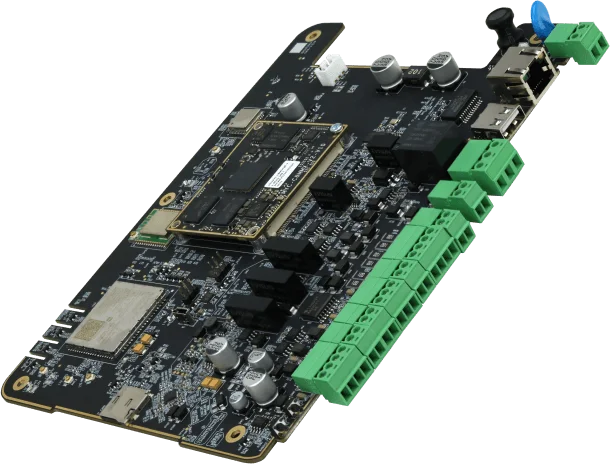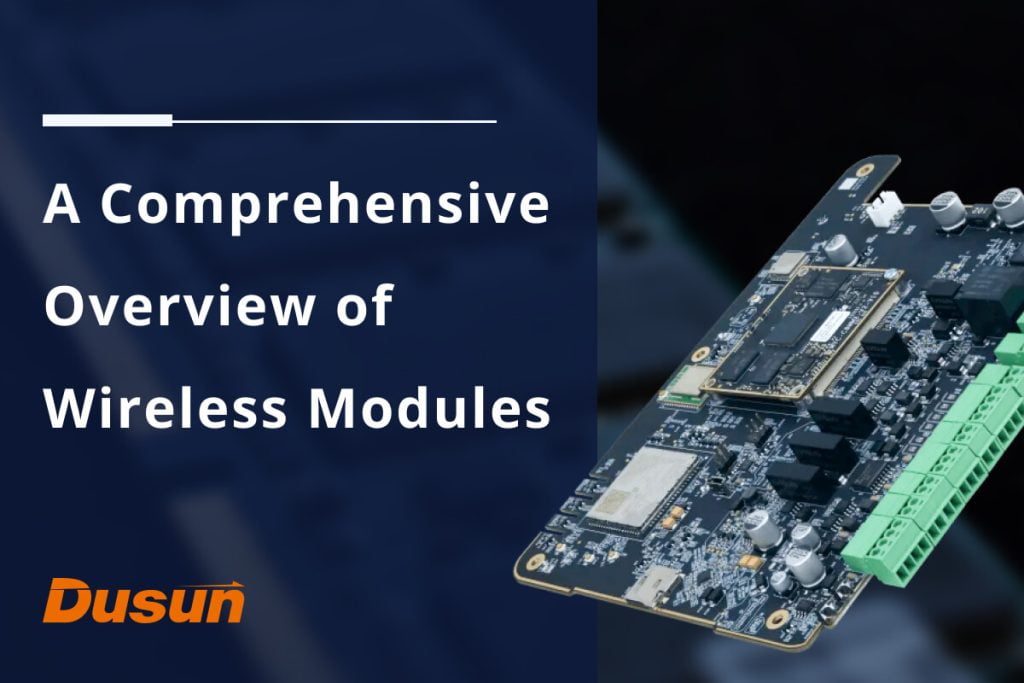Wireless modules find extensive applications in fields such as the Internet of Things (IoT) devices, embedded systems, smart homes, and industrial automation. In the context of IoT applications, for every additional IoT connection, 1 to 2 wireless modules are required. These wireless modules equip various terminal devices with the capability for networked information transmission, forming a critical link between the IoT sensing layer and the network layer.
Wireless modules encompass both cellular communication modules (2G/3G/4G/5G/NB-IoT, etc.) and non-cellular communication modules (WiFi, Bluetooth, LoRa, etc.), enabling devices to achieve wireless data transmission and communication.
Why Wireless Modules Are So Important?
The Internet of Things (IoT) gathers real-time data from objects that require monitoring, connectivity, and interaction, achieving pervasive connections between things and between things and people – a vast network of interconnected entities.
The cornerstone of IoT lies in wireless communication modules, which provide information transmission capabilities to a wide array of terminal devices. Every IoT endpoint relies on communication modules as intermediaries for data transmission. The relationship between the number of communication modules and the connections within the IoT is one-to-one, making communication modules the pivotal element in the “networking” aspect of IoT.

Wireless Module Industry
In the process of IoT solutions, for nearly every added IoT connection, there’s a corresponding addition of 1-2 wireless modules. The architecture of IoT is categorized into four layers: the perception layer, network layer, platform layer, and application layer. This structure forms a complete industry chain from “chip-module-terminal-operator-application.” Among them, wireless modules occupy a fundamental and core position within the architecture as they belong to the perception layer of IoT.
Read further: fundamental components of IoT
The wireless module industry chain comprises “upstream chip manufacturers – midstream communication module providers – downstream IoT applications.” Wireless module manufacturers procure chips, PCBs, discrete components, and other electronic elements from upstream suppliers. Through customized software and hardware design, testing, certification, and more, they enter downstream terminal applications, thereby propelling the development of the IoT industry.
Upstream: IoT Chip Manufacturers
The upstream of the wireless module industry chain consists of various electronic component manufacturers, such as chip, PCB, discrete component, and structural component suppliers. Among them, chips contribute to the most of the costs, with baseband chips, RF chips, and memory chips being the three major communication chips.
Read further: what are IoT chips?
The baseband chip boasts high technological barriers and accounts for the most material cost. Key suppliers include Qualcomm, Intel, MediaTek, Redpine Signals, and others. The PCB and passive components industries belong to a highly competitive market with strong substitutability.
Midstream: Wireless Module Manufacturers
Wireless communication modules reside in the midstream of the IoT industry chain. They integrate baseband chips, memory, capacitors, inductors, connectors, and other electronic components from upstream suppliers onto PCBs to achieve functions like user data collection and transmission.
Wireless modules constitute the IoT hardware foundation of ubiquitous connectivity. Benefiting from the rapid expansion of IoT, the wireless communication module industry is on a trajectory of rapid growth.
Downstream: Various Applications
In the downstream of the wireless communication module industry chain, smart IoT device manufacturers demand customization due to a wide variety of application scenarios such as smart manufacturing, autonomous driving, intelligent healthcare, smart education, and smart cities. This surge in IoT connections is driving rapid growth in wireless communication module market growth.
Types of Wireless Modules
Wireless modules can be categorized based on their functionalities, which include communication modules and positioning modules. Communication modules find a broader range of applications due to the fact that not all IoT terminals require positioning capabilities.
Communication modules are instrumental in establishing seamless connectivity between devices within the Internet of Things (IoT) network. They facilitate the exchange of data and information, enabling devices to communicate and interact effectively. These modules often incorporate various wireless communication technologies, such as Wi-Fi, Bluetooth, LoRa, Zigbee, and cellular networks. Their versatility allows them to cater to diverse IoT applications, from smart homes and industrial automation to healthcare and agriculture.
On the other hand, positioning modules are primarily focused on determining the geographical coordinates of devices. These modules leverage technologies like GPS, GLONASS, and Galileo to provide accurate location data. They are commonly used in applications where real-time tracking or geolocation services are essential, such as asset tracking, fleet management, and outdoor navigation systems.
The choice between communication and positioning modules depends on the specific requirements of the IoT application. While communication modules ensure seamless data exchange and connectivity, positioning modules offer precise location information that enhances tracking and monitoring capabilities.
4 Commonly Seen Wireless Communication Modules in IoT
In the realm of IoT, wireless communication modules play a pivotal role in enabling seamless connections among various devices. This overview delves into four prevalent wireless communication modules, shedding light on their functionalities and applications.
Bluetooth Modules
Bluetooth modules, a kind of integrated PCBA boards, bring Bluetooth capabilities to the forefront of short-range wireless communication. These modules are categorized into Bluetooth data modules and Bluetooth audio modules based on their functionalities. Generally, Bluetooth modules are semi-finished products, processed based on chips to simplify subsequent applications.
Read further: what is BLE SoC?
Designed to replace traditional data cables, Bluetooth facilitates point-to-point and point-to-multipoint communication, interlinking diverse data and voice devices within homes and offices. These connections create micro-networks (Pico-net) that can further aggregate into distributed networks (scatter-net), allowing for swift and convenient communication among interconnected devices.
WiFi Modules
WiFi modules encompass integrated hardware components designed to deliver WiFi communication functionality. These modules typically consist of WiFi communication chips, RF front-ends, antennas, and auxiliary circuits.
Read further: best WiFi module for IoT
WiFi communication chips serve as the module’s core component, managing various WiFi communication protocols and data transmission. RF front-ends amplify and filter RF signals to ensure stable and reliable WiFi communication, while antennas are critical for receiving and transmitting WiFi signals. Auxiliary circuits, including power supply circuits, clock circuits, and sensor interfaces, support the normal operation of WiFi modules and their connection to other devices.
LoRa Modules
LoRa modules center around their unique modulation technology, known as LoRa spread-spectrum modulation with frequency hopping. This innovation grants LoRa modules exceptional communication range and sensitivity, enabling reliable data transmission over long distances. Compared to traditional FSK and GFSK modulation techniques, LoRa modules exhibit stronger interference resistance, ensuring stability in complex wireless channel environments.
Read further: best LoRa modules
LoRa modules cover a wide frequency range, including 433/490/868/915 MHz, allowing for customization based on specific requirements. These modules find extensive applications in wireless meter reading, remote monitoring, environmental monitoring, and agricultural IoT. Their low-power characteristics result in prolonged device operation without frequent battery replacements.
4G Modules
4G modules are a comprehensive term for hardware integrated into specified frequency bands and software that supports standard LTE protocols. These modules integrate RF and baseband on PCB boards to execute wireless reception, transmission, and signal processing. Their software capabilities encompass voice dialing, SMS transmission, dial-up networking, and more.
Read further: what is Long Term Evolution?
Apart from providing high-speed data access, LTE 4G modules support both LTE-TDD and LTE-FDD standards, while also being backward compatible with 2G/3G communication protocols. With rich industrial standard interfaces and built-in network protocols, 4G modules cater to the diverse software and hardware requirements of IoT products. They find widespread use in industrial routers, smart gateways, security monitoring systems, connected vehicles, and other IoT applications.
Dusun IoT‘s wireless modules offer a wealth of interfaces for flexible customization, alongside corresponding product development kits, streamlining the product integration process and saving deployment time.
Final Words: How to Choose Appropriate Wireless Modules?
When considering module selection, it’s not only crucial to focus on the key functional parameters of the module itself, but also to take the following factors into consideration:
- What are the primary application scenarios for the wireless communication module?
- Is the module intended for use as a primary device or as an auxiliary device?
- What interfaces are available for invoking data transmission using the wireless module?
- Are there any specific interfaces that need to be configured?
- What is the data throughput of the wireless module?
- Can the module be customized to meet specific requirements?
… …
Making an informed decision involves evaluating not only the technical specifications of the wireless module but also understanding how it aligns with your intended use case and unique demands. By carefully considering these factors, you can ensure that the chosen wireless module product seamlessly integrates into your IoT project, providing optimal performance and functionality.



















